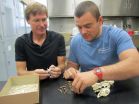(Press-News.org) [EMBARGOED UNTIL THURSDAY, JUNE 4] Although treatment advances have dramatically reduced deaths from opportunistic infections related to AIDS, a new study drawing on 30 years of data from more than 20,000 patients in San Francisco suggests there is still ample room to improve. About a third--35 percent--of AIDS patients diagnosed with their first opportunistic infection from 1997 to 2012 in that city died within five years, according to the study, published in the Journal of Infectious Diseases.
"While recent research suggests that many opportunistic infections in the U.S. are now less common and, oftentimes, less lethal, we cannot forget about them," said Kpandja Djawe, PhD, of the Centers for Disease Control and Prevention (CDC) and the lead author of the study, which included researchers from CDC and the San Francisco Department of Public Health. "We need to keep them in mind, even in the context of the changing epidemiology of HIV."
For the study, researchers analyzed HIV surveillance data collected continuously over the past 30-plus years by the San Francisco Department of Public Health on initial and subsequent AIDS-defining opportunistic infections, citywide, beginning in 1981.
Untreated HIV infection progresses to AIDS, opportunistic infections, and cancers. These were common during the early years of the U.S. epidemic, when death often quickly followed an AIDS diagnosis: From 1981 to 1986, only 7 percent of patients in San Francisco diagnosed with their first opportunistic infection lived more than five years, according to the study.
Since then, with advances in antiretroviral therapy (ART), wider availability of HIV testing, and improvements in the treatment of opportunistic illnesses, survival rates have markedly risen. During the most recent period analyzed in the study (1997 to 2012), 65 percent of patients diagnosed with an AIDS-related opportunistic infection lived five more years or longer, a trend consistent with other studies.
The remaining 35 percent of AIDS patients--those who died within five years of being diagnosed with an opportunistic infection--underscore the work still to be done to address AIDS-related illnesses today, the authors noted. "Better prevention and treatment strategies, including earlier HIV diagnosis, are needed to lessen the burden of AIDS opportunistic infections, even today, in the combination ART era," said Sandra Schwarcz, MD, senior HIV epidemiologist at the San Francisco Department of Public Health and one of the authors of the study.
Indeed, some of these infections, such as progressive multifocal leukoencephalopathy (PML), and infection-related cancers, including brain lymphoma, remain associated with substantial mortality risk today, the authors found, despite an overall improvement in survival rates. In addition, the health outcomes in San Francisco may be more favorable than in some other parts of the country, where HIV testing and treatment programs may be less robust.
"The results from San Francisco are encouraging, but highlight the need to remain focused on the potential for opportunistic infections to cause devastating disease,"
Henry Masur, MD, and Sarah W. Read, MD, of the National Institutes of Health, noted in a related editorial commentary. "A 35 percent mortality rate within five years of the initial AIDS-defining opportunistic infection leaves considerable room for improvement."
Fast Facts
AIDS opportunistic infections and infection-related cancers can strike when the immune system is badly damaged and HIV infection is not treated and progresses to AIDS.
From 1981 to 1986, only 7 percent of AIDS patients in San Francisco diagnosed with their first opportunistic infection lived more than five years. During the most recent study period (1997 to 2012), the five-year survival rate for these patients had improved to 65 percent.
Despite advances in treatment, 35 percent of the remaining AIDS patients diagnosed with their first opportunistic infection from 1997 to 2012 in San Francisco died within five years.
INFORMATION:
Editor's Note: The study and editorial authors' affiliations, acknowledgments, and disclosures of financial support and potential conflicts of interests, if any, are available in the study and editorial. The study and editorial are embargoed until 12:01 a.m. EDT on Thursday, June 4. These pre-publication links are for media access only:
Mortality Risk After AIDS-Defining Opportunistic Illness Among HIV-Infected Persons--San Francisco, 1981-2012
Opportunistic Infections and Mortality: Still Room for Improvement
Published continuously since 1904, the Journal of Infectious Diseases is the premier global journal for original research on infectious diseases. The editors welcome major articles and brief reports describing research results on microbiology, immunology, epidemiology, and related disciplines, on the pathogenesis, diagnosis, and treatment of infectious diseases; on the microbes that cause them; and on disorders of host immune responses. The journal is an official publication of the Infectious Diseases Society of America (IDSA) and the HIV Medicine Association (HIVMA). Based in Arlington, Va., IDSA is a professional society representing nearly 10,000 physicians and scientists who specialize in infectious diseases. For more information, visit http://www.idsociety.org. Follow IDSA on Facebook and Twitter.
Philadelphia, PA, June 4, 2015 - Children with Autism Spectrum Disorder (ASD) are often picky eaters, which can lead parents to suspect that their children might not be getting adequate amounts of vitamins and minerals. This sometimes leads parents of children with ASD to try nutritional supplements and dietary regimens such as gluten-free and casein-free (GFCF) diets without professional supervision. In the largest study of its kind, published in the Journal of the Academy of Nutrition and Dietetics, researchers report that these well-intentioned efforts can result in ...
In a new study, scientists have gathered all available NASA/ESA Hubble Space Telescope data on the four outer moons of Pluto to analyse the system in more depth than ever before. The observations show that at least two of Pluto's moons are not neatly rotating on their axes but are in chaotic rotation while orbiting around Pluto and its companion Charon. The study also hints that one of the moons has a mysterious jet-black colouring. These surprising results appear in the 4 June issue of the journal Nature.
Almost every moon in the Solar System, including our moon, rotates ...
SALT LAKE CITY, June 4, 2015 - At times during the past 10,000 years, cottontails and hares reproduced like rabbits and their numbers surged when the El Niño weather pattern drenched the Pacific Coast with rain, according to a University of Utah analysis of 3,463 bunny bones.
The study of ancient rabbit populations at a Baja California site may help scientists better understand how mammals that range from the coast to the interior will respond to climate change, says anthropology doctoral student Isaac Hart. He is first author of the study to be published in the ...
A rare and elusive rabbit has been found, held and photographed by a researcher from the University of East Anglia (UEA).
The Annamite Striped rabbit, found in the forests of Laos and Vietnam, was first documented by rabbit expert Dr Diana Bell and colleagues from UEA's School of Biological Sciences in the journal Nature in 1999. It has rarely been seen since.
Researcher Sarah Woodfin, who is studying for a Masters in Applied Ecology and Conservation at UEA, set out on a three-month expedition to track the recently-discovered rabbit and study its habitat.
But she ...
Many aquatic species have a reputation for negligent parenting. Having cast their gametes to the currents, they abandon their offspring to their fate. However, hands-on parenting is taken to a whole new dimension in the Syngnathidae fish family. Instead of leaving the responsibility to the females, seahorse and pipefish males take the pledge to care for their young even before the eggs are fertilized. The females depart soon after placing their eggs directly into the male's brood pouch, leaving the soon-to-be fathers to incubate the developing embryos. Ines Braga Goncalves ...
Cancer has overtaken cardiovascular disease, which includes heart disease and stroke, as the UK's No 1 killer--but only among men, reveals research published online in the journal Heart.
Cardiovascular disease is still the most common cause of death among women, and kills more young women than breast cancer, the figures show.
The researchers used the latest nationally available data (2012-13) for each of the four UK countries and the Cardiovascular Disease Statistics 2014 report compiled for the British Heart Foundation (BHF) to quantify the prevalence of cardiovascular ...
Researchers have developed a score that predicts an individual's risk of dying within 5 years for people aged between 40 and 70 years old in the UK, according to new research published in The Lancet.
The score, which uses measures that can be obtained by simple questionnaires without any need for physical examination, such as self-rated health and usual walking speed, could be used by individuals to improve awareness of their health status, and by doctors to identify high-risk individuals for further treatment, say the authors.
Individuals can calculate their personalised ...
Women aged 50-69 years who attend mammography screening reduce their risk of dying from breast cancer by 40 per cent compared to women who are not screened - according to a major international review of the latest evidence on breast cancer screening.
Overall, women who are invited to attend mammography screening have a 23 per cent risk reduction in breast cancer death (owing to some attending and some not), compared with women not invited by routine screening programmes.
In the UK, this relative risk translates to around eight deaths prevented per 1,000 women regularly ...
ANN ARBOR, Mich. - Day in and day out, for years on end, millions of people with diabetes prick their fingers to test their blood sugar level. And many may wonder if all the careful eating, exercise and medication it takes to keep those levels under control is really worth it.
A major new study should encourage them to keep going for the long haul, to protect their hearts from diabetes-related damage. But it should also prompt them to work with their doctors on other ways to reduce their cardiovascular risk.
The key finding: that keeping blood sugar levels under good ...
Boston, MA - A new study by researchers at Harvard T.H. Chan School of Public Health found that death rates among people over 65 are higher in zip codes with more fine particulate air pollution (PM2.5) than in those with lower levels of PM2.5. It is the first study to examine the effect of soot particles in the air in the entire population of a region, including rural areas. The harmful effects from the particles were observed even in areas where concentrations were less than a third of the current standard set by the Environmental Protection Agency (EPA).
"Most of the ...

